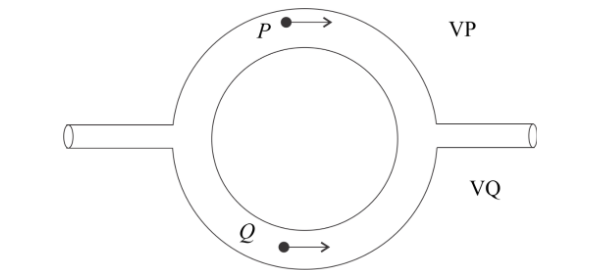
Figure shows a liquid flowing through a tube at the rate of $0.1{m^3}/s$. The tube is branched into two semi-circular tubes of cross-sectional area $A/3$(upper) and $2A/3$(lower). The velocity of liquid at Q is (the cross section of main tube is $A = {10^{ - 2}}{m^2}$ and ${v_P} = 20m/s$)

(A) $5m/s$
(B) $30m/s$
(C) $35m/s$
(D) None of the above
Answer
219.6k+ views
Hint Volume of liquid pass through the main tube per second is equal to sum of volume of liquid pass through the both semi-circular tubes per second. We know that the volume of liquid passing through a cross section in one second is a product of the cross-sectional area and speed of liquid. We just find the rate of flow in P and Q, and equate then with the rate of flow of the main tube.
Complete step by step solution
The rate of flow of liquid in the main tube is $0.1{m^3}/s$ and area of the main tube is $A = {10^{ - 2}}{m^2}$.
Let ${v_P}$ and ${v_{\text{Q}}}$ are velocities of liquid in tube P and Q respectively.
As given ${v_P} = 20m/s$.
Cross sectional area of tube P and Q is $A/3$ and $2A/3$ respectively.
Rate of flow of liquid in tube P is ${R_P} = {v_p} \times \dfrac{A}{3} = \dfrac{{20A}}{3}{m^3}/s$.
Rate of flow of liquid in tube Q is ${R_{\text{Q}}} = {v_{\text{Q}}} \times \dfrac{{2A}}{3}{m^3}/s$
We know that the rate of flow of the main tube is equal to the sum of the rate of flow of tube P and Q.
Then, $\dfrac{{20A}}{3} + \dfrac{{2A{v_{\text{Q}}}}}{3} = 0.1$ or $20A + 2A{v_{\text{Q}}} = 0.3$
${v_{\text{Q}}} = \dfrac{{0.3 - 20A}}{{2A}}$
Putting value of A in above equation, we get
${v_{\text{Q}}} = \dfrac{{0.3 - 20 \times 0.01}}{{2 \times 0.01}} = \dfrac{{0.3 - 0.2}}{{0.02}} = 5m/s$
Hence the correct answer is option A.
Note: For a junction of liquid flow pipes, liquid entered at the junction is equal to liquid leaving the junction. Here liquid enters at the main junction and liquid enters from the main tube and liquid leaves the junction and flows in tube P and Q as shown in figure.
Complete step by step solution
The rate of flow of liquid in the main tube is $0.1{m^3}/s$ and area of the main tube is $A = {10^{ - 2}}{m^2}$.
Let ${v_P}$ and ${v_{\text{Q}}}$ are velocities of liquid in tube P and Q respectively.
As given ${v_P} = 20m/s$.
Cross sectional area of tube P and Q is $A/3$ and $2A/3$ respectively.
Rate of flow of liquid in tube P is ${R_P} = {v_p} \times \dfrac{A}{3} = \dfrac{{20A}}{3}{m^3}/s$.
Rate of flow of liquid in tube Q is ${R_{\text{Q}}} = {v_{\text{Q}}} \times \dfrac{{2A}}{3}{m^3}/s$
We know that the rate of flow of the main tube is equal to the sum of the rate of flow of tube P and Q.
Then, $\dfrac{{20A}}{3} + \dfrac{{2A{v_{\text{Q}}}}}{3} = 0.1$ or $20A + 2A{v_{\text{Q}}} = 0.3$
${v_{\text{Q}}} = \dfrac{{0.3 - 20A}}{{2A}}$
Putting value of A in above equation, we get
${v_{\text{Q}}} = \dfrac{{0.3 - 20 \times 0.01}}{{2 \times 0.01}} = \dfrac{{0.3 - 0.2}}{{0.02}} = 5m/s$
Hence the correct answer is option A.
Note: For a junction of liquid flow pipes, liquid entered at the junction is equal to liquid leaving the junction. Here liquid enters at the main junction and liquid enters from the main tube and liquid leaves the junction and flows in tube P and Q as shown in figure.
Recently Updated Pages
Chemical Equation - Important Concepts and Tips for JEE

JEE Main 2022 (July 29th Shift 1) Chemistry Question Paper with Answer Key

Conduction Explained: Definition, Examples & Science for Students

Analytical Method of Vector Addition Explained Simply

Atomic Size - Important Concepts and Tips for JEE

JEE Main 2022 (June 29th Shift 1) Maths Question Paper with Answer Key

Trending doubts
JEE Main 2026: Application Form Open, Exam Dates, Syllabus, Eligibility & Question Papers

Understanding Uniform Acceleration in Physics

Derivation of Equation of Trajectory Explained for Students

Hybridisation in Chemistry – Concept, Types & Applications

Understanding the Angle of Deviation in a Prism

Understanding Collisions: Types and Examples for Students

Other Pages
JEE Advanced Marks vs Ranks 2025: Understanding Category-wise Qualifying Marks and Previous Year Cut-offs

Units And Measurements Class 11 Physics Chapter 1 CBSE Notes - 2025-26

NCERT Solutions For Class 11 Physics Chapter 8 Mechanical Properties Of Solids

Motion in a Straight Line Class 11 Physics Chapter 2 CBSE Notes - 2025-26

NCERT Solutions for Class 11 Physics Chapter 7 Gravitation 2025-26

Mechanical Properties of Fluids Class 11 Physics Chapter 9 CBSE Notes - 2025-26




